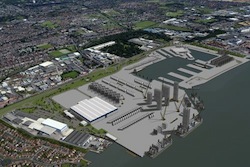 Siemens will be investing £160 million (EUR190m) in wind turbine production and installation facilities in Yorkshire (UK). The facility will be spread across two sites including the Green Port Hull project construction, assembly and service facility and a new rotor blade manufacturing facility in nearby Paull, in East Riding. Siemens’ port partner Associated British Ports (ABP) is investing a further £150 million in the Green Port Hull development. The investment will provide a huge boost to the UK’s offshore wind industry and the Humber region.
Siemens will be investing £160 million (EUR190m) in wind turbine production and installation facilities in Yorkshire (UK). The facility will be spread across two sites including the Green Port Hull project construction, assembly and service facility and a new rotor blade manufacturing facility in nearby Paull, in East Riding. Siemens’ port partner Associated British Ports (ABP) is investing a further £150 million in the Green Port Hull development. The investment will provide a huge boost to the UK’s offshore wind industry and the Humber region.
“This is a massive vote of confidence in our long-term economic plan,” said Prime Minister David Cameron. This investment is going to create lots of new jobs and opportunities, meaning more financial security and peace of mind for families and a more resilient economy for our country.”
The Green Port Hull project has been in development for nearly four years and is the product of an effort between many national and local political, business and community parties and many people within Siemens in the UK, Denmark and Germany, and ABP. The investment is a landmark moment for the UK offshore wind industry. It is the first manufacturing plant of its kind for Siemens next generation blade technology (IntegralBlade) designed for Siemens SWT-6.0-154 6 megawatt (MW) wind turbine. Each rotor blade is 75 meters long and when rotating covers an area the size of two and a half football pitches.
“Our decision to construct a production facility for offshore wind turbines in England is part  of our global strategy: we invest in markets with reliable conditions that can ensure that factories can work to capacity,” said Michael Suess, member of the managing board of Siemens AG and CEO of the Energy Sector. “The British energy policy creates a favourable framework for the expansion of offshore wind energy. In particular, it recognizes the potential of offshore wind energy within the overall portfolio of energy production.”
of our global strategy: we invest in markets with reliable conditions that can ensure that factories can work to capacity,” said Michael Suess, member of the managing board of Siemens AG and CEO of the Energy Sector. “The British energy policy creates a favourable framework for the expansion of offshore wind energy. In particular, it recognizes the potential of offshore wind energy within the overall portfolio of energy production.”
Suess continued, “The offshore wind market in Great Britain has high growth rates, with an even greater potential for the future. Wind power capacity has doubled here within two years, to roughly 10 gigawatts. By 2020, a capacity of 14 gigawatts is to be installed at sea alone to combine the country’s environmental objectives with secure power supply. Projects for just over 40 gigawatts are currently in the long-term planning.”
Green Port Hull is planned to be operational to meet Round 3 requirements in early 2016. The start of production at the blade factory is scheduled to be in the middle of 2016 with full production levels reached from mid 2017 onwards.

